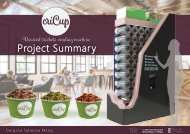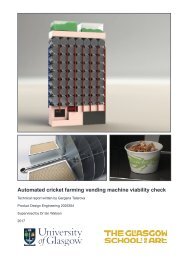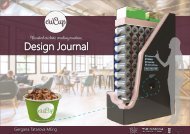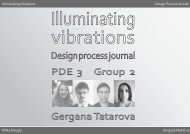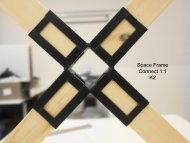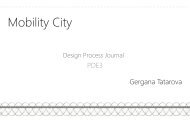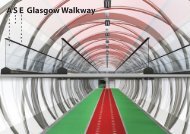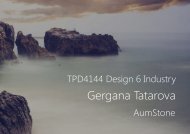D5_GR4_FINAL_DOCUMENTATION_spreads
You also want an ePaper? Increase the reach of your titles
YUMPU automatically turns print PDFs into web optimized ePapers that Google loves.
GRUPPE 4<br />
DESIGN 5 - SYSTEMS DESIGN<br />
25.11.15<br />
CHRISTER REBNI<br />
GERGANA TATAROVA<br />
KAROLINE RYE FINCKENHAGEN<br />
ROSIE BOUGHTON<br />
TRULS JOHANSEN<br />
01
YGGDRASIL<br />
02<br />
THE FUTURE<br />
04<br />
CONCEPT<br />
06<br />
SCOPE<br />
07<br />
KEY IDEAS<br />
08<br />
SYSTEM OVERVIEW<br />
010<br />
YGGDRASIL<br />
TABLE OF CONTENTS<br />
COMPONENTS<br />
PROCESS<br />
014<br />
018<br />
A submerged, windmill-powered fish farm<br />
set 15 - 25 years in the future.<br />
MODEL BUILDING<br />
COLLABORATION<br />
020<br />
021<br />
02<br />
EVALUATION<br />
023<br />
03
THE FUTURE<br />
PREDICTIONS AND POSITION<br />
04<br />
It did not take much research to figure<br />
out that an offshore setting means a serious<br />
increase in complexity, especially if<br />
you continued to operate under the<br />
current fish farming paradigm. But<br />
would you? Let us say we look 15 - 25<br />
years into the future.<br />
We had to find our position on future<br />
fish farming - and see which parts of the<br />
paradigm we could change. If one watches<br />
Hans Rosling and his visualizations<br />
of UN data, the trend is for a denser<br />
populated, but more healthy and better<br />
educated world. A denser population<br />
means more demand for food and less<br />
area to grow it, while better overall health<br />
and education leads to a higher demand<br />
for healthy and sustainable food with a<br />
concern for animal welfare.<br />
The other important future prediction is<br />
relating to energy. Fish farming is not the<br />
only industry that needs to be<br />
transformed when moved offshore.<br />
There will also be wind farms. The<br />
shipping industry must transform as well<br />
in reaction to emission restrictions, and<br />
eventually shift further away from fossil<br />
fuels.<br />
The other important future prediction is relating<br />
to energy. As fish farms move offshore,<br />
so does windmills for energy generation.<br />
Could there be a synergy? And as emission<br />
restrictions tighten and fossil fuels are<br />
phased out, the shipping industry too must<br />
invest in green alternatives. Will we see<br />
commercial sail ships once again? Can the<br />
windmills charge ships?<br />
At the same time, we expect the problem<br />
of lice to continue, and as with all such<br />
biological issues, once you solve one, another<br />
one soon takes its’ place. In addition,<br />
weather exposure at the ocean surface will<br />
probably be even more extreme in the<br />
future.<br />
We challenged ourselves to make a proposal<br />
for the whole offshore fish farm.<br />
05
SCOPE<br />
15 - 25 YEARS IN THE FUTURE<br />
This is an offshore submerged fish farm<br />
in a 15 - 25 years future. We challenged<br />
ourselves to look at the full system. All<br />
modules have been designed to play into<br />
and support the system as a whole.<br />
06<br />
CONCEPT<br />
Therefore we set our scope to include<br />
only enough detail to ensure that the<br />
components open up opportunities instead<br />
of ferming them shut.<br />
To design for the future, you must first<br />
put in the effort to research how the<br />
world is evolving and make some tough<br />
predictions about the future based on this<br />
newly gained information.<br />
07
COMMERCIALIZATION<br />
As the industry matures and standardization<br />
ensues, larger portions of the fish<br />
farm will be sold as integrated products.<br />
This is important for our solution. We<br />
envision it not as a one-off, but as a<br />
system sold to multiple sites around the<br />
world - a system with a substantial market<br />
share to offset the investment cost.<br />
08<br />
KEY IDEAS<br />
STANDARDIZATION<br />
Aquanor gave the impression of an<br />
industry still on the rise. We saw<br />
diverging paradigms (closed vs. open,<br />
offshore vs. onshore farming), still many<br />
small vendors - some of them even doing<br />
well with unpatented solutions. Every<br />
fish farm, every well boat and every barge<br />
seems to be a custom job - at least up<br />
until now.<br />
As industries mature, they standardize.<br />
The competition between paradigms,<br />
between technologies and processes,<br />
results in winners. The winners become<br />
standards. In 15 - 25 years, we expect this<br />
to have happened in fish farming. This is<br />
why our system contains more<br />
standardized modules with standardized<br />
integrations between them.<br />
AUTOMATION<br />
There is a large potential for automation<br />
in the fish farming industry. By studying<br />
the material gathered from Aquanor and<br />
learned through our excursion to Hitra,<br />
it is apparent that manual labour is a big<br />
part of today’s operations; both physical<br />
labour and manual integration of sensors,<br />
systems and actuators. As we move<br />
towards more standardized systems, there<br />
is an opportunity for more automation.<br />
And as we move offshore, where labour<br />
is more expensive, automation becomes a<br />
more profitable investment.<br />
09
SYSTEM OVERVIEW<br />
We built a physical model of the system,<br />
showing the elements we chose to focus<br />
on within our scope.<br />
Our fish farm is a system of several cages<br />
clustred around a windmill. We decided<br />
that bringing the system further offshore<br />
justifies scaling it up to approximately 1<br />
million fish per cage.<br />
The windmill supplies power to the fish<br />
farm as well as sending most of its generated<br />
enery to the mainland. Operations<br />
are automated, and the need for manual<br />
labour is minimized. Transportation and<br />
storage are standardized.<br />
In our concept we also include<br />
multi-purpose submersible containers:<br />
transportation pods. These are carried<br />
by much more nimble ships than today’s<br />
well-boats.<br />
Fish wellfare is improved through a more<br />
natural handling of the fish, and lice are<br />
eliminated by submerging the cages underneath<br />
the depth of the lice zone.<br />
010<br />
011
WINDMILL<br />
CATAMARANS<br />
The windmill is our Yggdrasil.<br />
It provides power to all of the elements<br />
in our system, feed to the cages, and also<br />
- permanently or at times - physically<br />
connects all of the features.<br />
Pods are transported by nimble<br />
catamarans - becoming trimarans when<br />
grasping onto the semi-boatshaped transportation<br />
pod. Thay have a sail capability,<br />
and an electric propulsion that is<br />
recharged at the windmill.<br />
CAGE<br />
They contain the fish in an environment<br />
that facilitates fish welfare, with the<br />
artificial airtight air-bubble as our main<br />
feature here. The pods dock to the roof of<br />
the cage, securing an escape-proof way of<br />
harvesting the fish.<br />
FEEDING SYSTEM<br />
The transportation pods hold food from the<br />
mainland. At the fish farm they dock to the<br />
windmill, feed is tranferred into the feed<br />
storage within the windmill, and distributed<br />
to the cages through feeding tubes.<br />
TRANSPORTION PODS<br />
ROBOTIC ARM<br />
012<br />
They hold both smolt and feed as it is<br />
transported out to the fish farm. They<br />
store feed for a while when they dock to<br />
the windmill and transport harvested fish<br />
back to shore.<br />
It sits on top of the cage, and takes care<br />
of all daily and periodic maintenance.<br />
013
COMPONENTS<br />
01. TRANSPORTATION PODS<br />
The tanks are used for transporting food<br />
as well as live smolt and fish. On site,<br />
they are used for food storage, docked to<br />
the windmill and attached to the food<br />
distribution system. The tanks are multi-purpose,<br />
and have buoyancy regulation<br />
to allow submerging and surfacing on<br />
demand.<br />
To deliver smolt and pick up harvest<br />
ready fish, they are connected to the cages<br />
in a submerged state. Physical reduction<br />
of space in cage or container is combined<br />
with more fish-friendly techniques like<br />
electromagnetic manipulation and controlled<br />
feeding to move the fish between<br />
cage and tank.<br />
03. WINDMILL<br />
The windmill is a lot taller than onshore<br />
ones, being 250 metres tall.<br />
It is therefore able to generate a lot of<br />
power, and is a sustainable source of<br />
energy for both the fish farm and locations<br />
on the mainland. The feeding system<br />
is centred at the windmill. The windmill<br />
also pumps air into the cage for the<br />
features where this is needed.<br />
02. CATAMARAN<br />
Tanks are transported by nimble<br />
catamarans - becoming trimarans when<br />
grasping onto the semi-boatshaped tank.<br />
These catamarans avoid the added weight<br />
needed to store the container in the ship;<br />
iAnstead it is simply docked to the ship.<br />
The catamarans have a sail capability, and<br />
electric propulsion that they can recharge<br />
at the windmill.<br />
014<br />
015
06. CAGE<br />
The cages are submerged to get them<br />
beneath the lize zone, and away from<br />
airborne predators and harsh weather<br />
conditions. An airtight air-bubble with<br />
artificial lighting inside provides a controllable,<br />
simulated water surface. This<br />
supports fish welfare. feeding and creates<br />
a natural habitat for the fish.<br />
016<br />
04. FEEDING SYSTEM<br />
When feed is transported to the fish farm<br />
with catamarans, the feed is stored inside<br />
transportation pods. The pods cluster<br />
around the windmill and connect to it.<br />
The feed is stored inside the pods until<br />
it is needed. When needed, the food is<br />
transferred to a feed storage compartment<br />
within the windmill, and is distributed to<br />
the cages via feeding tubes.<br />
05. ROBOTIC ARM<br />
With nets, there is always cleaning and<br />
fixing to be done. Examples are removal<br />
of dead fish on a daily basis, and manual<br />
repair of equipment such as the feeding<br />
connections. Our robotic arms can traverse<br />
the net and reach all parts of it on<br />
their own. Fixing them to the top of the<br />
cage means avoiding having to constantly<br />
fight the current like an R.O.V. would.<br />
We spent quite some time looking at<br />
different cage solutions and decided not<br />
to focus on the netting or cage operations<br />
themselves, but rather to propose a<br />
solution that opens many opportunities<br />
and serves the system as a whole.<br />
1 million fish per cage<br />
5% fish to 95% water<br />
Diameter: 72 metres. Height: 30 metres<br />
Top of cage: 20 metres below the surface<br />
017
THE PROCESS<br />
18<br />
PROCESS<br />
This course was set up to be an iterative<br />
process for all groups. We spent some<br />
time initially studying fish farming and<br />
today’s problems in general, and then<br />
started thinking up and researching possible<br />
solutions to those problems. Many<br />
of the final concepts were thought up<br />
in that early phase, and for some facets<br />
of the system we came up with several<br />
alternatives which were shuffled around,<br />
decided and re-decided through the<br />
process.<br />
The overall process was typical of the<br />
“double diamond” model of design thinking.<br />
We diverge to explore all facets of<br />
a problem, before we converge on a well<br />
founded problem definition.<br />
After this, one diverges to explore several<br />
possible solutions, before again converging<br />
on the final proposal, just like we<br />
did. The iterations over this process can<br />
vary a lot - you could go through both<br />
phases, then re-do the solution definition,<br />
or go back and revisit the problem<br />
definition.<br />
In our project, we did many small iterations<br />
- although we did not have to start<br />
completely anew.<br />
Around mid-term, we had a presentation<br />
for Hans Vanhauwaert Bjelland, the SIN-<br />
TEF manager in charge of the “Exposed”<br />
project which was our external partner<br />
for <strong>D5</strong>.<br />
Some components got questioned - like<br />
the proposed “monorail” attached to the<br />
power cable for fish and food transport.<br />
This was the first major external challenge,<br />
and prompted another reiteration of<br />
our solution definition.<br />
Professor Matthijs van Dijk later did a<br />
workshop with us where we really got<br />
into details on the future predictions,<br />
statement and behaviours. In effect - we<br />
revisited and reiterated on the problem<br />
definition, strengthening in it and reaffirming<br />
the decision to simplify some<br />
components to make the system concept<br />
stronger.<br />
019
MODEL BUILDING<br />
We wanted the model to catch attention<br />
and communicate our concept. The first<br />
goal required a level of detail and realism<br />
above what we could achieve with grey<br />
unpainted cardboard, it could not be too<br />
abstract. The last goal required that we<br />
pushed the most important modules into<br />
the most dominant visual positions and<br />
avoided unimportant distractions.<br />
We have a fantastic workshop with many<br />
opportunities at IPD, and with this this<br />
model, we have really taken full advantage<br />
of it. Sea floor modeled in SolidWorks,<br />
digitally sliced and laser cut. Cages hand<br />
stitched from lace fabric. A meticulously<br />
lathed windmill, and the boats, pods and<br />
pod docking facilities were 3D-printed in<br />
a powder bed printer.<br />
Logics<br />
Control<br />
Logical<br />
Analytical<br />
Fact-Based<br />
Quantitative<br />
Sequential<br />
Organized<br />
Detailed<br />
Planned<br />
Holistic<br />
Intuitive<br />
Integrating<br />
Synthesizing<br />
Feeling-based<br />
Interpersonal<br />
Kinesthetic<br />
Emotional<br />
Vision<br />
People<br />
In the beginning we were maybe a bit too<br />
unfocused. Some say we were chaotic.<br />
We would say that we experimented with<br />
creativity and the double diamond model<br />
of design thinking. How much divergence<br />
could we get - how could we tear open<br />
the current paradigms of fish farming -<br />
and still converge on a final product we<br />
were proud of and could defend?<br />
We were a group with strong personalities,<br />
and a good span of the scale from<br />
introvert to extrovert. If you look at a<br />
typical personality test with four personality<br />
types (see illustration), our group did<br />
perhaps lack a clearly green personality,<br />
but we have group members who are<br />
certainly capable of taking more control<br />
when needed. In the end, we were very<br />
happy with our result although some<br />
activities were started too late or not kept<br />
under enough control.<br />
020<br />
COLLABORATION<br />
There was, of course, a lot of “killing<br />
your darlings”. Some members of the<br />
group felt this happened too often for<br />
their babies, but it was often necessary<br />
to clean up the concept, make it easier to<br />
understand and communicate in the final<br />
presentation.<br />
021
EVALUATING OUR RESULTS<br />
022<br />
HAPPY TEAM<br />
We are very proud of our achievements<br />
in this project. We managed to get many<br />
iterations and very diverging solutions to<br />
result in a convergence towards an<br />
understandable concept; a concept that is<br />
well aligned with the predictions and position<br />
we set in our session with Matthijs<br />
Van Dijk.<br />
We overcame issues with cooperation to<br />
utilize everyone’s strengths. This was especially<br />
important since we were a mixed<br />
group with both exchange students and<br />
NTNU students who did not know each<br />
other from before.<br />
We feel that our model is a beautiful rendition<br />
of our concept, showing the scale,<br />
but at the same time the simplicity and<br />
scalability of it. It caught a lot of attention<br />
at the presentation.<br />
We wish we could have gotten to do<br />
more research and had even better<br />
calculations to show. However, at the<br />
same we feel that we can defend the<br />
proposals we came up with as a possible<br />
and promising vision for the future of<br />
offshore fish farming.<br />
023




